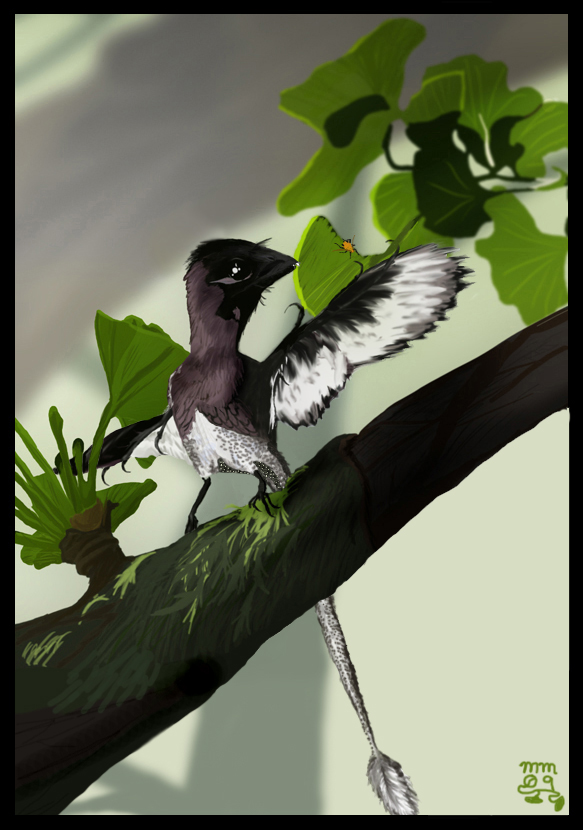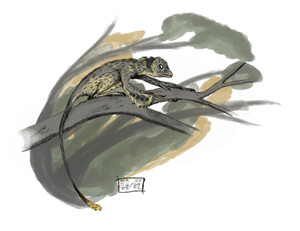home > natural history
Scansoriopteryx heilmanni
"Heilmann's climbing wing"

click here to buy a print of the original verison
Scansoriopteryx heilmanni was one of the smallest dinosaurs and the first "scansor" (members of the family Scansoriopterygidae) to be discovered.
Named for the influential paleontologist and paleoartist Gerhard Heilmann (one of the first scientists to propose a close link between birds and dinosaurs), and for its supposed arboreal lifestyle, Scansoriopteryx was officially described shortly before the very similar looking Epidendrosaurus. For a while there was discussion over whether these two "aye-aye dinosaurs" (so called for their very long third finger, superficially similar to the probing finger of certain lemurs) were actually the same species, and if so, which should have priority of name (Epi was published online before Scansor hit print, but Epi didn't hit print until even later).
The question is still open, with few published opinions on the matter, though opinions offered online have helped demonstrate that the several lines of evidence used to separate the two were probably based on misinterpretations. It's not evident here (I purposely kept this feature ambigouos for this painting), but the fossil Epi had a much longer tail than the truncated tail preserved in Scansoriopteryx. While relatives do seem to have short tails, it's more likely that the tail in the Scansor type specimen is simply incomplete. Additionally, the first toe (hallux) of Epidendrosaurus does not appear to be reversable, at least not all the way, while the authors of Scansoriopteryx claimed that it had a fully reversed hallux, better for gripping small twigs. It's more likely that both were unreversed, with the toe simply lowered on the foot, as in therizinosaurs. Scansoriopteryx also preserves long feathers on the arm and hand, while these are not preserved in Epi or in the related Epidexipteryx (which also has a very short bony tail). Like Microraptor, Scansoriopteryx also had a short fan of feathers on the tip of the tail, for either display or aerodynamic reasons. Oddly, it also preserves a patch of scales on the underside of the tail base, possibly for bracing against trees. Epi and Scansor do seem to be synoynms and, unless in the unlikely event that the ICZN passes a retroactive amendment on the validity of online names, Scansoriopteryx wins priority.
The phylogenetic position of the scansors is still rather uncertain, but they probably were some type of avialan or even basal maniraptorans, sitting on a very primitive branch of the bird family tree. The similarity of their feet to the functionally four-toes therizinosaurs would also argue for their position as more primitive maniraptors than has otherwise been suggested in print.
The Scansoriopteryx reconstructed here is a hypothetical sub-adult. It is using its unusually long third finger (a feature unique to scansors among all dinosaurs) to grip a Ginkgo twig, on which sits a small hemipteran insect, all of which lived together in the ecosystem found in the Daohugou fossil beds of Inner Mongolia, China. The reason for the long finger is unknown: it's robust compared to the other fingers, and unlikely to have been a probing instrument, unlike the probing finger of the aye-aye, which is very thin. It could have been elongated to support a "para-wing" of feathers, in contrast to modern-style wings where the feathers anchor on digit 2, or (as I've restored here) simply been elongated to extend past the wing to grasp and manipulate objects.
The discovery of a complete, adult scansor specimen (Epidexipteryx) helps to fill in some gaps in our knowledge of this Epi, and I've modified my original painting to include a wider snout and forward-pointing teeth, perfect for snapping up small insects.
The size comparison chart at right shows both the tiny hatchling specimen, as well as a speculative adult based on the size of the related Epidexipteryx.
For more on Scansoriopteryx , see the Wikipedia
article I helped edit.
Image Details:
Media: Digital painting, Adobe Photoshop CS using WACOM Graphire 3
Purchase link: DeviantArt
License:
All Rights Reserved
DESCRIPTION
Length: ~25cm (10in)
Weight: ~164g (5.7 ounces)
Location: Daohugou Beds, Nei Mongol, China
Time: Oxfordian age, Upper Jurassic, (154 Ma)
CLASSIFICATION
Kingdom: Animalia
Phylum: Chordata
Class: Stem-Aves
Family: Scansoriopterygidae
Genus: Scansoriopteryx
Species: S. heilmanni
SYSTEMATICS
Sauropsida
Diapsida
Archosauria
Ornithosuchia
Dinosauria
Theropoda
Coelurosauria
Maniraptora
Scansoriopterygidae

Above: Scale chart, hatchling (left) and hypothetical adult.
